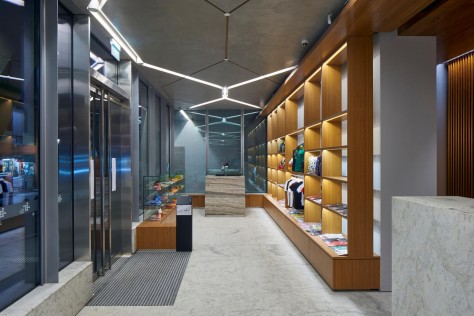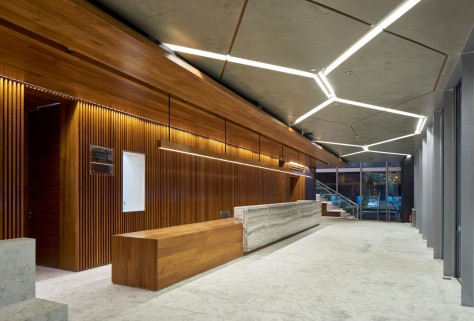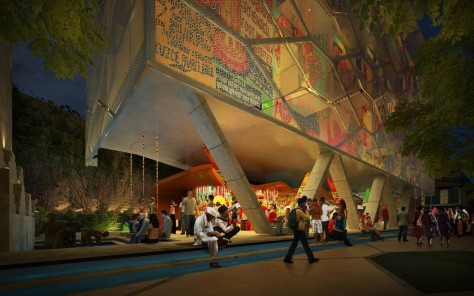
The National Heritage Board wanted a sustainable contemporary building that would embrace the vibrant streetscape of the area and its people. Singapore’s first Indian Heritage Centre (IHC) would feature small-scale museum facilities as well as community and educational spaces. The space requirement was for two large galleries for the permanent collection, a special gallery for changing exhibitions, and an activity space for smaller groups that could be closed off when in use, or opened up to complement the special exhibition gallery.

In terms of energy efficiency, the brief stipulated that while the environmental control requirements were to be strictly adhered to for the galleries (relative humidity and temperature), the building should achieve a minimum Green Mark GOLD rating. The diversity and multi-faceted nature of Indian culture is captured in the use of a translucent shimmering façade to create an impression of the IHC as a “shining jewel” in the day, and transforming into a “glowing lantern” at night. The most distinctive motif of the building is a pattern created from the geometry of the baoli, an Indian stepped well that is a lifeline and traditional source of water, as well as a meeting point for the community.

The baoli also represents an active environment where the young and old interact, stories are told, and tradition is passed on. The baoli is translated onto the façade via the composition of the curtain wall glazing, with staircases serving as a three-dimensional jali (intricate ornamental openwork typically found in Indian and Islamic architecture), modulating light, air and views between the streetscape and the galleries. In opening up the gallery experience to the street, visitors to the IHC become ‘actors’ against the colourful gallery wall, enticing passers-by to look in and engage with the building.

Another design inspiration is the five-foot way, which refers to the traditional five-foot wide covered pedestrian walkways along rows of shophouses, usually found in Singapore and Malaysia. This concept has been expressed as a vertical circulation core in the façade of the IHC. Staircases within the façade provide access between the galleries, and afford visitors a visual connection to the street. Where there are no stairs, apertures in the gallery wall act as small balconies for the display of changing exhibits that are visible from the street as well as the gallery, further opening up the IHC experience to passers-by in the street below.

The galleries were conceptualised as repositories of calm and reflection, and offer visitors a respite from the hustle and bustle of Little India. Materials and lighting were designed to focus the visitor experience on the objects and exhibits within the galleries. As the galleries are relatively small, dark surfaces are used to increase the perception of depth, with lighting focused on the artifacts, which appear to float within the space. The oscillation between light and dark, openness and closure — as visitors move between the galleries via the façade staircase — enhances the visitor experience and reconnects them with the street outside. A unique part of the building is the design of the façade curtain wall glazing.

The entire curtain wall is suspended from the upper row of reinforced concrete landings. To keep steel member sizes to a minimum and provide additional support, stainless steel tension wires were employed, while lateral movement is controlled via connections to concrete landings at all levels. The intricately carved entry portal is the most significant architectural element of the building at street level, and an important element in traditional Indian architecture. The objective was to create an architectural language for the structure of the building, with the entry portal defining its identity. The portal was carved in south India from three large blocks of granite, in a village near Mahabalipuram (a UNESCO heritage site) in Tamil Nadu.

The carving gives a tactile quality to the building entrance, in contrast to the utilitarian and bare off-form finish of the other columns. A carved fivemetre-high teak door is tucked inside the portal, providing a further layer of richness and inviting visitors to approach and touch the building. To allow the artwork and mural to take centrestage, natural and raw materials were mostly used for the building. Teak, off-form concrete, steel, glass and plain granite are the primary materials used, with travertine marble providing a focus in the lobby area. The travertine for the main reception counter and one external feature wall was sourced from the Middle East.

The blocks were handpicked and book-matched to create a continuous pattern of the stone’s stratified layers. In a way, the travertine reflects the multilayered richness of the Indian community in Singapore. The original proposal was to use the external wall of the galleries as a canvas for visual artists, who would be commissioned to create colourful mural installations. The artwork would be changed every three to five years, allowing the identity of the building to evolve over time.

Currently, the mural is a collage of archival images put together by the National Heritage Board. The building comes to life with light in the evening. LED fixtures are integrated into the design of the curtain wall structure. The lights on the mural wall can be dimmed to highlight the colour-changing LED light fixtures as they dance across the façade, set to the rhythm of classical Indian music. The ‘sequences’ for the LED lighting will be changed throughout the year to mark festivals and special events within the IHC calendar.

Hence, during the day, the building seemingly blends into its surroundings as its glazed façade reflects the adjacent colourful conservation shophouses. At night, when the streetscape colours are muted, the building comes to life with light and colour, creating a “glowing lantern” in Little India. The imaginative use of colour was recognised when the IHC was named runner-up in the Colour in Architecture category in the World Architecture News 2013 Awards. The original mural submitted was by British-Indian pop artist, Ketna Patel. Greg Shand and Gaurang Khemka are the proud Winners of – International Design Competition for the Singapore Indian Heritage Centre awarded by the National Heritage Board of Singapore. Source by Robert Greg Shand Architects.

Location: Singapore
Architects: Robert Greg Shand Architects, URBNarc
Project Team: Robert Greg Shand, Gaurang Khemka, Luther Maynard Sim, Avy Hizole Janda, Anna Lourdes Dayan
Urban Design & General Advisory Consultant to RGSA: URBNarc Pte Ltd
Main Contractor: Yong Xing Construction Pte Ltd
Gallery Fitout Design: gsmprjct creation pte ltd
Project Management: SIPM Consultants Pte Ltd
Landscape Consultant: Robert Greg Shand Architects
Civil & Structural Engineer: Surbana International Consultants Pte Ltd
Façade Consultant: Passage Projects
Mechanical & Electrical Engineer: Mott Macdonald Singapore Pte Ltd
Quantity Surveyor: Franklin + Andrews Pte Ltd
Lighting Consultant: Ong + Ong Pte Ltd
Land Area: 1033.80 m2
Built‐in GFA: 3089.68 m2
Year: 2015
Photographs and Images: Courtesy of Robert Greg Shand Architects













